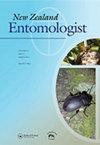The feeding habits of Wiseana (Lepidoptera: Hepialidae) species on a traditional Māori food crop
IF 0.4
4区 农林科学
Q4 ENTOMOLOGY
引用次数: 0
Abstract
ABSTRACT For Māori the kūmara symbolises the extensive voyages from the ancestral home of Hawaiki to Aotearoa New Zealand and the ingenuity needed to adapt growing practices for a tropical crop to the climate of New Zealand. From the thirteenth century, kūmara cultivation occurred along the coastlines in the warmer regions of New Zealand where its associated pests were controlled by traditional methods. In 1952, an observation was made indicating that Wiseana, an endemic genera of ghost moths, possibly fed on kūmara. The current study investigates the feeding habits and preferences of laboratory-reared Wiseana copularis and W. cervinata larvae for kūmara through no-choice and choice test bioassays. Kūmara tuber provided the largest mean weight gain for the two Wiseana species with a 122% increase by week 6 compared to white clover foliage. The mean weight gain of larvae fed with kūmara leaf, kūmara stem or white clover were not significantly different. All kūmara and white clover options were equally selected by larvae within the two-choice tests, therefore there was no differential preference for the kūmara plant material. This data indicates that the polyphagous herbivore larvae of Wiseana spp. may have fed on kūmara in traditional kūmara gardens, supporting the early published record. Further research is needed to determine if Wiseana larvae are affecting kūmara production today. Ki te Māori ko te kūmara e hua ai ngā hekenga maha ā ngā tīpuna mai i a Hawaiki ki Aotearoa, me ā rātou mōhiotanga ki te whakatipu i te kūmara ki te āhuarangi mātoke o Aotearoa. Nō te rautau tekau mā toru i whakatipu ai ngā kumara ki ngā takutai o Aotearoa ā, i āraia atu ngā mate, ngā kīrearea mā te whakaritenga tūturu. I te tau 1952 nō te tirohanga mai o te porina (Wiseana) kainga pea e te pūrehurehu taketake i ngā kūmara. Ko te rangahau o naianei ko ngā whiringa me ngā hiahia o te kai ā ngā torongū porina i whakatipu ai i roto i te taiwhanga pūtaiao ki roto i te whakamātau kore-kōwhiri, te whakamātau kōwhiri rānei. Ko te kōpura i whakaputa ai i te taumaha nui ake i te 122% i te taumaha o te korowa i te wiki tuaono. Kāhore he taumaha tino rerekē mō te whā me te kakau o te tipu ki te korowa. Kei roto i te kōwhiri whakamatau, ko ngā kūmara katoa me ngā korowa i kōwhiringia ōritengia ai e te huhu, nā reira kaore kau he mea rerekē mo te hiahiatanga o te tipu kūmara. I te mutunga, ē whakaatu ana te raraunga nei, kainga pea e te kaitipu huhu i ngā kūmara o ngā māra tūturu, hei tautoko hoki tēnei i ngā tuhinga o mua. Ma te rangahau anō ka kitengia mehemea ka pāngatia tonutia e te huhu (Wiseana) i te whakanaonga o ngā kūmara o naianei.一种传统Māori粮食作物上Wiseana(鳞翅目:Hepialidae)的摄食习性
摘要对毛利人来说,kāmara象征着从夏威夷祖籍到新西兰奥特亚的漫长航程,以及使热带作物的种植方式适应新西兰气候所需的独创性。从13世纪开始,在新西兰较温暖地区的海岸线种植kúmara,那里的相关害虫是通过传统方法控制的。1952年,一项观测表明,鬼蛾的特有属Wiseana可能以库马拉为食。本研究通过无选择和选择测试生物测定,调查了实验室饲养的Wiseana copularis和W.cervinata幼虫对kāmara的食性和偏好。库马拉块茎为两个Wiseana物种提供了最大的平均体重增加,到第6周,与白三叶草叶片相比增加了122%。用金缕梅叶、金缕梅茎或白三叶草喂养的幼虫的平均增重没有显著差异。在两种选择测试中,幼虫对所有kúmara和白三叶草的选择都是相同的,因此对kúmara植物材料没有不同的偏好。这些数据表明,Wiseana spp.的多食性食草动物幼虫可能在传统的kúmara花园中以kúmara为食,这支持了早期公布的记录。需要进一步的研究来确定Wiseana幼虫是否影响了今天的kāmara生产。Ki te Māori ko te kāmara e hua ai ngāhekenga mahaāngātīpuna mai i a Hawaiki Aotearoa,meārātou Mōhiotanga Ki te whakatipu i te kúmara Ki teāhuarangi Mātoke o Aotearo。Nōte rautau tekau mātoru i whakatipu ai ngākumara ki ngātakutai o Aotearoaā,iāraia atu ngāmate,ngākīrea māte whakaritenga túturu。1952年,我在威斯康辛州(Wiseana)种植豌豆。Ko te rangahau o naianei Ko ngāwhiringa me ngā。Ko te kōpura i whakaputa ai i te taumaha nui ake i te 122%i te taamaha o te korowa i te wiki tuaono。Kāhore he taumaha tino rerekımōte whāme te kakau o te tipu ki te korowa。Kei roto i te kōwhiri whakamatau,ko ngākúmara katoa me ngākorowa i k艴whiringia \33396 ritengia ai e te huhu,nāreira kaore kau他表示重新阅读。我是穆通加,我是拉劳加·奈伊,我是凯恩加豌豆和凯蒂普·胡胡。Ma te rangahau anōka kitengia mehemea ka pāngatia tonutia e te huhu(Wiseana)i te whakanaonga o ngākúmara o naianei。
本文章由计算机程序翻译,如有差异,请以英文原文为准。
求助全文
约1分钟内获得全文
求助全文
来源期刊

New Zealand Entomologist
ENTOMOLOGY-
CiteScore
0.70
自引率
33.30%
发文量
3
审稿时长
>12 weeks
期刊介绍:
The invertebrate diversity of New Zealand is of great interest worldwide because of its geographic isolation and geological history. The New Zealand Entomologist plays an important role in disseminating information on field-based, experimental, and theoretical research.
The New Zealand Entomologist publishes original research papers, review papers and short communications. We welcome submissions in all aspects of science regarding insects and arthropods in a New Zealand or Australasian setting. The journal’s subject matter encompasses taxonomy, phylogenetics, biogeography, biological control and pest management, conservation, ecology and natural history.
The journal is the official publication of the Entomological Society of New Zealand. Papers published or submitted elsewhere for publication will not be considered, but publication of an abstract or summary elsewhere (e.g. conference proceedings) does not preclude full publication in the New Zealand Entomologist. Accepted papers become copyright of the Entomological Society of New Zealand. The journal is published in English, but we also welcome publication of abstracts in Maori.
 求助内容:
求助内容: 应助结果提醒方式:
应助结果提醒方式:


